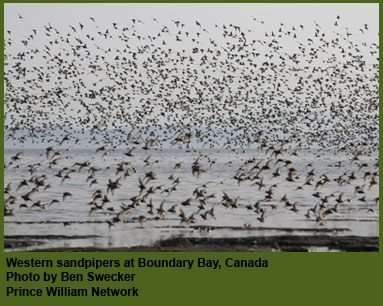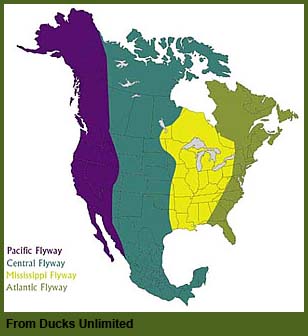Fraser River Delta and Boundary Bay
British Columbia, Canada
The Fraser River is the longest river in British Columbia, Canada originating in the Rocky Mountains near Mount Robson and flowing for 1400 km (870 mi), into the Pacific Ocean at the city of Vancouver.
The Fraser River is at a critical crossroads along the Pacific Flyway. The paths of many migrant birds converge at the Fraser River Delta. Its location mid-way along the Pacific Coast makes it an international crossroads of bird migration routes from 20 countries and three continents. Waterfowl and shorebirds from breeding grounds in Siberia, Alaska, Yukon, and other arctic and prairie areas all stop to refuel in the Fraser River estuary on their way to wintering grounds in California, Mexico, Central and South America or the South Pacific. 
Coastal lowlands and marshes of the estuary provide critical refueling opportunities for long-distance migrants such as the Lesser Snow Goose, which nests in Wrangel Island (Russia) and sometimes makes non-stop flights of over 2,500 km in its southward migration to wintering grounds.
Almost all of the world's population of western sandpipers stop to rest and refuel during their massive migrations between Alaska nesting grounds and wintering sites from California to Peru. In addition, more than 35 other shorebird species rely on this estuary throughout the year.
Green-winged Teal, American Wigeon, Gadwall, Northern Shoveler, Northern Pintail, Lesser Snow Geese, Trumpeter Swans are the most commonly-observed waterfowl species seen inshore. In deeper waters, large rafts of diving ducks such as Greater and Lesser Scaup and Surf Scoters congregate, along with Double-Crested Cormorants, Western Grebes and many species of gulls. Dunlin and Western Sandpipers feed in flocks of thousands on intertidal mudflats, marshes and lowland habitats inland of the dykes. Bald Eagles, Northern Harriers, Red-tailed Hawks, Peregrine Falcons and Short-Eared Owls are just some of the birds of prey to be seen in the river delta. For some species such as the Barn Owl, the delta represents the only site in Canada with mild enough winters for the species to remain year-round.
British Columbia's estuaries are among the richest in the world. The Fraser River is home to over 400 species of vertebrates, thousands of plants, and a myriad of small invertebrates.
The Fraser River forms the largest estuary along the Pacific Coast of North America and drains over 200,000 square kilometers of British Columbia. River sediments meet the currents of the Strait of Georgia and are deposited onto the nearly 30,000 hectares of the estuary's intertidal marshes and mudflats.
The climate is mild, and there are plentiful foods ranging from marine fish and invertebrates to grasses, rodents, and amphibians. Millions of birds all congregate at the mouth of this river, providing a wonderful wildlife viewing spectacle.
The Fraser River is the largest producer of salmon on the entire Pacific Coast of North America. Annually, millions of anadromous (migratory) adult salmon migrate upstream to spawn along small streams along its length and up into the connected waterways. Millions of young fish hatching in these areas spend their early life cycle in these upper reaches, and eventually descend to the estuary on their way out to oceanic habitats. Estuarine marshes, mudflats, floodplains, sloughs and river channels are all critical feeding and rearing areas for these and other fish during their transition between river and marine stages of their life cycle. Pacific Herring, Sturgeon, Eulachon, and Smelt are also abundant fisheries locally, as are Dungeness crab, shrimp and other invertebrates. 
The Fraser River Estuary has received global recognition as a Wetland of International Significance and has been proposed as a WSHRN site. (The abbreviation WSHRN stands for the Western Hemispheric Shorebird Reserve Network, an international initiative to identify and protect habitats in key stopover points used by shorebirds during their long migrations across North and South America (the Western Hemisphere). The Fraser delta ranks very highly, since almost all of the world's population of western sandpipers stop to rest and refuel during their massive migrations between Alaska nesting grounds and wintering sites from California to Peru. In addition, more than 35 other shorebird species rely on this estuary throughout the year.
(From the British Columbia Waterfowl Society: http://www.reifelbirdsanctuary.com/fraser.html)











